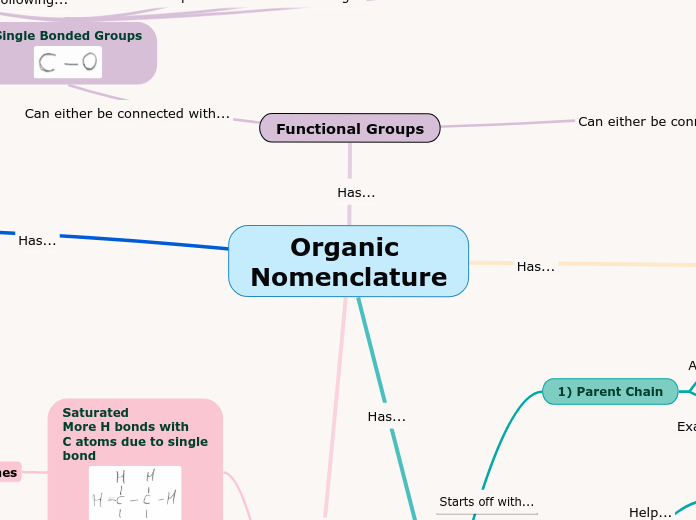Organic Nomenclature
Reactions
One product
Addition
When atoms are added to form a double or triple bond
Reduction
Creates more bonds with H and fewer with O
Oxidization
When a reactant is oxidized an another is reduced
Two or more products
Substitution
When a functional groupe is replaced with another group
Elimination
Reverse of addition where an atom is removed to from a double bond
Condensation
Two organic molecules join to form one organic molecule with water molecule
Hydrolysis
When water splits a bond into two
Has...
Functional Groups
Single Bonded Groups
Hydroxyl Group
Alchohols
Suffix: -ol
Ethanol
Multiple -OHs
Diol, Triol, Tetra
Ethane-1,1-diol
Primary
The carbon with the
hydroxyl is bonded to
one other carbon
C has 2 H bonds and 1 R
bond
Secondary
The carbon with the
hydroxyl is bonded to
two other carbon
C has 1 H bond and 2 R
bonds
Tertiary
The carbon with the
hydroxyl is bonded to
three other carbon
C has no H bonds and 3 R
bonds
Haloalkanes/Alkyl Halides
Named with prefixes:
(fluoro-,chloro-,bromo-,iodo-)
Trichloromethane
Ethers
Adding -oxy to branches
2-ethoxypropane
Amines
Suffix: -amine
Propan-1-amine
Double Bonded Groups
Carbonyl Group
Carboxylic Acids
Suffix: -oic acid
Propanioic Acid
Esters
Suffix: -oate
Propyl Ethanoate
Aldehydes
Suffix: -al
Methanal
Amides
Suffix: -amide
Methanamide
Ketones
Suffix: -one
Butanone
Basic Alkene/ane/yne
Saturated
More H bonds with
C atoms due to single
bond
Alkanes
Single bonds between carbons
Each molecule differes from prevous by adding -CH2- (homologous series)
Suffix: -ane
Propane
Unsaturated
Due to double/triple
bond, less H bonds with
C atoms
Alkenes
Double bond between carbons
Suffix: -ene
Propene
Cis
An isomer in which
largest groups on C
atoms are attached on
the same side
Cis-2-butene
Trans
An isomer in which
largest groups on C
atoms are attached on
the opposite sides
Trans-2-butene
Alkynes
Triple bond between carbons
Suffix: -yne
Propyne
Naming
1) Parent Chain
Is the longest chain of carbons
Longest carbon chain
2) Root
Denotes the number of C atoms in longest parent chain
8 carbon atoms
3) Prefix
Given postions and names of any branches
4th postion and 2
carbons in a branch
Branches
Number of carbons that aren't connected to the parent chain
4) Suffix
Indicates what type of hydrocarbon it is
Remove -e and
add -ane
Cylic Hydrocarbons
Aromatic Hydrocarbons
Benzene/Phenyl
Root: -benzene
Suffix: no suffix
When carbon chain has more than 6 carbons the benzene is considered a side group and named phenyl group
Methylbenzene
Cylcloalkanes
Root: -cyclo
Suffix: -ane
Cyclopentane
Cycloalkenes
Root: -cyclo
Suffix: -ene
Cyclohexene
